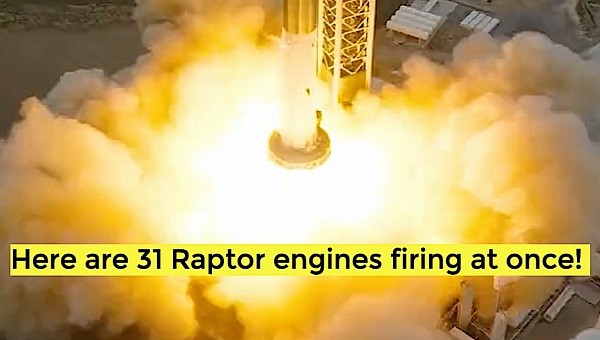Over the next few months, the most anticipated and high-profile development on the space exploration stage is the long-awaited launch of the SpaceX Starship. After all, we're talking about the first privately made and operated spaceship that will be capable of traveling to the Moon, and perhaps even Mars, opening up entirely new possibilities for our expansion into the solar system.
We have then more than enough reasons to get all worked up about this. But before it gets to do all of the above, the thing will first have to prove it can reach orbit. It should have done this a long time ago, but rocket science being what it is, it got delayed time and again.
When he last said something on the subject, Elon Musk hinted that March 2023 is probably the best bet to see the Starship take off and move past the Karman line, the agreed limit to space. And seeing how the company just performed the first full-blown static fire test of all the Starship booster’s 33 Raptor engines, it’ll probably happen just as predicted.
Just a few hours ago, SpaceX’s facility in Boca Chica, Texas, witnessed the ignition of all the rocket's 33 engines, but not all completed their mission. According to Musk himself, one of the engines cut off just before ignition, and the other stopped working soon after, but the remaining 31 engines went through the full burn, which lasted only seconds. And that’s more than enough for the rocket to reach orbit.
All 33 engines are attached to the Starship Booster 7. When they finally ignite for the mission itself, they’ll push the booster and the capsule it carries, Ship 24, into Earth orbit. The booster will then come back down and land on its designated pad, while Ship 24, it too equipped with six Raptor engines, is expected to make one full orbit around our planet, and then splash down off the coast of Hawaii. From launch to hitting the water no more than 90 minutes will have passed.
Although to some people the success of the Starship launch may seem like just another way to please a billionaire’s ego, the hardware is in fact crucial for the NASA Artemis Moon exploration program.
SpaceX is the company that supplies the lunar lander for the Artemis III mission. Called Starship Human Landing System (HLS), it will actually be a variant of the existing Starship. Artemis III will also require a series of preparatory SpaceX missions, including one to place a storage depot in Earth orbit from where the HLS to fuel itself when it goes to the Moon.
In the longer run, the Starship may form the basis of a rocket and spaceship family that could finally allow humans to take that bold journey to Mars. So, we have a lot of reasons to root for the success of Starship’s first orbital flight, and for now at least, things are looking pretty good.
When he last said something on the subject, Elon Musk hinted that March 2023 is probably the best bet to see the Starship take off and move past the Karman line, the agreed limit to space. And seeing how the company just performed the first full-blown static fire test of all the Starship booster’s 33 Raptor engines, it’ll probably happen just as predicted.
Just a few hours ago, SpaceX’s facility in Boca Chica, Texas, witnessed the ignition of all the rocket's 33 engines, but not all completed their mission. According to Musk himself, one of the engines cut off just before ignition, and the other stopped working soon after, but the remaining 31 engines went through the full burn, which lasted only seconds. And that’s more than enough for the rocket to reach orbit.
Although to some people the success of the Starship launch may seem like just another way to please a billionaire’s ego, the hardware is in fact crucial for the NASA Artemis Moon exploration program.
SpaceX is the company that supplies the lunar lander for the Artemis III mission. Called Starship Human Landing System (HLS), it will actually be a variant of the existing Starship. Artemis III will also require a series of preparatory SpaceX missions, including one to place a storage depot in Earth orbit from where the HLS to fuel itself when it goes to the Moon.
In the longer run, the Starship may form the basis of a rocket and spaceship family that could finally allow humans to take that bold journey to Mars. So, we have a lot of reasons to root for the success of Starship’s first orbital flight, and for now at least, things are looking pretty good.








